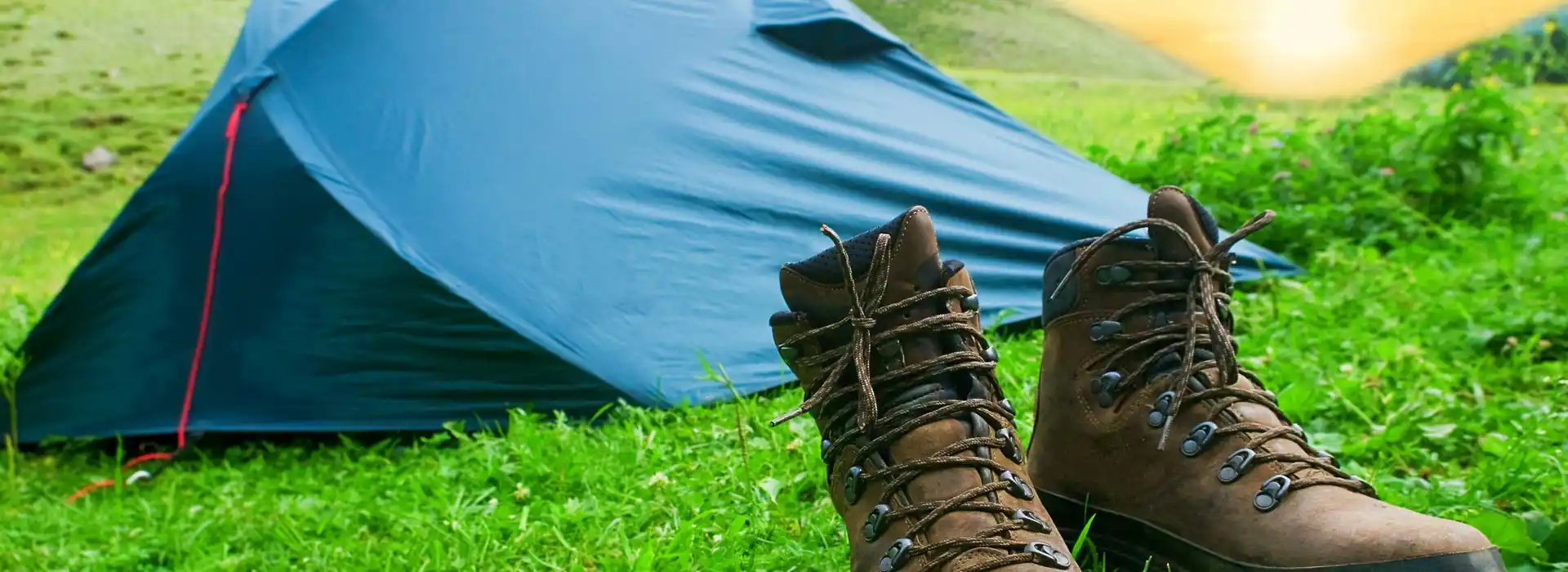A big part of the reason you bought the tent was so that you'd have a nice dry roof above your head, so it's undoubtedly a disappointment if you start getting wet inside. For the best possible outcome, you'll need to choose a tent that stands up to the weather and have a few tricks up your sleeve to keep it working at its best. Plus, if things do get wet inside, there's a lot you can do to air and dry out the interior quickly.
Tent waterproofing
Are tents waterproof when you buy them?
Condensation can often form and drip on the inside - this looks a lot like rain, but so long as you haven’t got water coming in from outside all you need is ventilation. So the first step is to check, is it really leaking or is that the moisture from your family’s breath?
Synthetic tents should be waterproof from day one. If a new synthetic tent is leaking, hurry back to the retailer for a quick refund.
On a new cotton or poly-cotton tent the fibres swell when damp and seal off the little holes left by stitching so you do need to wet the tent to make it sealed against the rain – this is known as ‘weathering’. Poly-cotton tents will never be as waterproof as polyester tents, but the advantages of the more comfortable living environment far outweigh the small amount of water that may enter the tent.
How do I waterproof a tent?
A modern synthetic tent should not need reproofing, other than seam sealing, as polyester has an inner waterproof layer from the time it’s made.
On the outside synthetic tents have a coating that makes the rain bead and run off quickly, so to replace that a quick spray of Fabsil or any other tent waterproofing spray is useful. It’ll help the tent dry off better, but it’s not enough for fully keeping the elements at bay.
The other possibility for a synthetic tent is that the seams are leaking. This is much more common with older style tents, and on these you can use a tent seam sealer. It’s a kind of clear rubbery glue that you apply with a brush, simple and easy.
A leaky tent is not necessarily a write off – simple re-waterproofing for your much-loved piece of kit can be done using a reproofer such as a tin of liquid Fabsil and it will be as good as new at a cost of roughly £50 per treatment! It may be worth testing the tent with a stint in your garden first, to find out if it needs proofing first. Or, if you don't feel 100% certain you know how to waterproof the tent, call the manufacturers for their professional advice.
Actually my tent isn’t leaking, but how do I get rid of all this condensation?
As you’d expect the problem comes down to ventilation, especially in damp and cold weather. Taking a warm sleeping bag and keeping a little air flow in the tent, will make a big difference. Cotton tents are less likely to suffer from this, as the fabric breathes.
If possible, avoid bringing wet kit into the inner tent, and leave it in a porch if you have one. An inner lining on your tent will help to prevent drips, so a double skinned tent could be the solution. If you get one particular drip running down a pole that is driving you barmy, tie a soft cloth around that pole to soak it up.
How do you dry out a wet tent?
There are times when nature leaves you with no choice to pack up a wet tent. If that happens, bear in mind that you have a maximum of two days to get the tent to a place where it can dry out properly to prevent any risk of damage.
Remove the guy lines as they hold onto water, and metal parts to fend off any orange rust marks. Then shake off as much water and grass as possible, you’ve done all you can for now. Try to open the tent bag a little, or ideally keep it out of the bag and in somewhere cool to buy you time until you can dry it out.
But, if you want to use it again next year, it’s essential you put it away properly when it’s bone dry. Try re-erecting it in your garden, or if you’ve a big garage or loft, hook it on the wall to dry. It shouldn’t take longer than a day to get rid of all the moisture, if properly aired - but it must be pitched taut.
If you religiously end your camping season each year by hanging your tent indoors until perfectly dry before you store it, you’re likely to never need our mildew advice, luckily!
What happens if mildew develops?
The reason for painstakingly drying out tents is to avoid the unwelcome guest: mildew. You’ll know it’s there when you see small black splotches on the tent surface. If yours is just on the inner tent you are safe to wash it off properly with soap, water and sponges.
If it’s on the outside, throw away all the usual soap, harsh chemicals or hard brushes as these could damage the surface. What’s most important is to kill the mildew to prevent it spreading, don’t worry too much about how it looks - no tent has ever won a fashion competition anyway.
The first choice is to use sunlight to kill the mould, and then brush it off gently. Of course, bright sunshine isn’t always on offer, so there’s a back up plan.
The second choice is to use a gentle bleaching agent, such as Milton, since it’s low chlorine. This will kill the mildew and remove the staining but could easily remove the colour from cotton based fabrics, or protective coats from your tent, too- watch out! Before you even attempt it, do a mini patch test on a hidden corner of the tent. Use Milton diluted in a 1:10 ratio and wash it off thoroughly after 15 minutes, to save your tent’s colour!
To be on the safe side, after using any chemicals all tents should be re-waterproofed, so take a look at the instructions on waterproofing a tent above. On polyester tents do some seam sealing too so that you don’t find any puddles inside.
How do you spot clean common stains from a tent?
So you’re home, lungs full of the outdoors, and you spot a disappointing gift from a rural bird on your prized tent. Don’t worry, because there’s plenty that can be done.
Your best option is to brush off the dry ‘doings’ or wipe (not scrub) with tiny bit of soap and water (choose soap that is mild and PH-neutral). By avoiding anything harsh, you won’t strip the tent’s coating, and won’t need to re-proof it.
But what if your tent is nicely decorated with tree sap, instead? First check that it’s not honeydew from aphids. Honeydew is sticky but will wash off easily in water, so breathe a sigh of relief if it’s that.
Proper tree resin gets heated and melted in the sun like wax so it can get everywhere on your tent before drying rock hard, and become more of a nightmare. One option is to let it dry and then crack it off, but there’s a risk you may remove important tent layers. Another is to try using a professional clean guard and water guard treatment, which won’t remove the finish underneath.
Oil and grease spots on a tent can be soaked up as much as possible with a soft sponge and water. But, unfortunately, going any further is likely to damage the tent - so try to live with a small mark!
What if the tent sags?
The most likely reason is a little hitch in putting it up – not surprisingly, as some tents are complex to put together! The big culprit could be your poles, which may not all be the same size, so check they are in the right sleeves. If you have trouble matching them up, you can colour code with a little dab of nail varnish on the pole and corresponding sleeve.
The next possibility would be guy ropes, and whether they’re pulled at the right angle or tautness. Search images online of your particular tent type professionally set up and follow where their lines are going. Your ropes also don’t need to be so taut they ping when you flick them, but just enough to hold the slack and keep everything in place, in general.
How do you store your tent when not in use?
You’ve just arrived home with your new pride and joy and you realise it’s somewhat bulky. As we learned from mildew 101, it also needs to be somewhere dry and without extremes in temperature, so where can your new beauty go?
A tent does need a certain amount of TLC, so popping it in a cupboard in the house, or nestled under a bed is ideal. If you’re short of space, a loft can work well.
If you’re sure your garage is dry and free from damp, you’ll need to keep pesky mice from nibbling on your camping gear with a large, strong and thick storage container and fitted lid. Indoor storage is often safer, however!
Your comments about this article
Alan
21/04/2019 21:15I was trying to find a site where I can take a tourer onto a site and leave it there. I would hope they would store it over winter and over the season I could just go to it as and when I wanted to. I am willing to pay an annual site fee to include electric and gas. Can you advise as I am a novice in this area
Martin Smith
22/04/2019 09:01Have a look at our listings of 250+ sites offering seasonal pitches Alan :-)
- Why go camping?
- Camping statistics
- How to plan a camping trip
- Equipment and gear: what to take camping
- How to choose a campsite
- Camping etiquette and campsite rules
- Choosing a pitch and setting up camp
- Breaking camp
- How to keep warm when camping
- How to avoid midges, wasps and other insects while camping
- Camping with dogs
- Camping with campfires
- Camping tips, hacks and tricks
- Beware carbon monoxide poisoning
Download our list of everything of you need to remember for the perfect camping trip!
DownloadIn the UK, you don't have to travel far to see some amazing sights.
We're lucky enough to have world-besting landscapes, history and wildlife right on our doorstep.
Where will you explore next?
Explore Destinations


